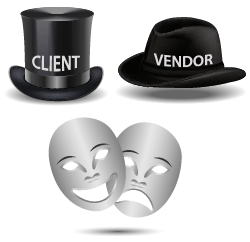
The unwritten law of water treatment and desalination projects states that 75% of their execution success depends on how fast you place the purchase orders. In other words, your success is in the hands of your suppliers and vendors.
Fostering connectivity with vendors adds the same quality value as launching new technology or service. So proactive and consistent tracking, perpetual re-evaluation, and selecting new suppliers should be part of any agile business, big or small, startup or corporation.
Surprisingly enough, they are not as lack of formal framework makes them perceived as time- and resource-consuming adventures with a high risk of failure.
How to enrich the vendor - client experience and turn the bunch of above-mentioned tasks into an amazing opportunity? By splitting it into small steps or micro-services described below.
1. List eligible vendors
The first easy step is just to count and list all the vendors related to your business area, using search engines like Google, Bing, or even LinkedIn. The vendors shall be classified according to the product types, technology standards, experience, and range of services. Such a preliminary screening is a big time saver during the project's execution. Later you can more readily adapt your business requirements to vendor capabilities.
For the water industry, this work has been already done by crenger.com. It offers OEMSE - an original equipment manufacturer (OEM) search engine. Unlike many general-purpose engines, it uses technical terminology describing the construction and the process in which the equipment searched for is used. The engine gives you a hint about the most popular selections. In addition, you may score your past experience with a particular manufacturer (from full satisfaction to complete miss). In the future, this engine is planned to extend to the engineering services providers.
2. Track vendor credibility
Credibility is a compound result of many vectors: reputation in the market, reference clients, partnering, strategy changes, stability of leadership, management mission, major deals, resources stability and layoffs, posts, publications, and public seminars.
Tracking may reveal some vendor problems or unknown competitive edge, which may be leveraged to the customer's advantage. Today with the information aggregators like LinkedIn and Water Network this task may be readily implemented.
3. Record vendor client's feedback
In B2C e-commerce (AliExpress, eBay, Amazon.com) it is normal to ask the buyer to rate the transaction - communication with the seller, the accuracy of the product description, and shipping time. This online feedback is an important part of the host company's business model as it helps other buyers assess products and suppliers.
Similar approach exists in industry and B2B commerce: both extensively use the vendor ratings criteria offered by Gartner. Every year it publishes open (!) reviews of business "health" on many companies. Analyzed are competition strength, financial performance, vision, strategy, sustainability, and others.
Why don't in the water industry the vendor ratings go beyond obtaining the reference list with the former clients' contacts? I filed several dozens of them over my career and I never touched them afterwards.
The answer is simple - new skills beyond procurement are required to build a framework for recording, processing, and reporting vendor data. The latter is business specific. In infrastructure projects, we may start by asking customers to comment and rate their experience in the following groups (applying the Gartner scale - weak, caution, variable, positive, and strong): on-time delivery, fault resolution, technical expertise, knowledge sharing, and collaboration.
Vendors with high ratings will equally enjoy this assessment judging by the popularity of Gartner's reports.
Crenger offers an OEMRATE application for quick evaluation of the vendors. It allows you to leave feedback on OEMs and rate their performance.
4. Monitor vendor assessment
Vendor Assessment shall determine if a prospective vendor can effectively meet the obligations and needs of the business (standards, technology, and quality). It is a questionnaire covering a broad range of subjects like company management, quality system, product design and development, resources, handling non-conformities, sub-vendors selection, risk management, and financial security.
In practice, this information is never used in decision-making due to its huge volume and lack of a simple evaluation procedure.
OEMSUV application from crenger.com runs the vendor survey and offers tips on how to improve the ranking, and selects the best. This application collects and processes the vendor data, and alerts vendors of the assessment renewal.
5. Educate vendor on your business requirements
"Vendors' Corner" shall be one of the requirements for the corporate website. It should describe the process of pre-qualification of new vendors and existing ones. One of the important documents - purchasing terms and conditions - shall be easily found.
The site shall also contain a document and drawings templates library to be used by subcontractors during the project execution. An example of this library may be found here.
6. Product affinity assessment
It shall answer two questions: "What does the bidder do?" and "How close is the bidder to the dream product?" This micro-service eases the entry of a new supplier and substantially enhances its chances to win. It allows the supplier to match its products to the ones procured in the past. The more matches found - the less the risk to miss the specification objectives in future projects. Product matcher replaces the practice of asking for the reference list and trying to assess the manufacturer's product range affinity level. Normally this risk-associated task is executed by domain experts. For example, only the pump expert may decide whether to give the green light to the manufacturer not having the requested product but having the engineering and manufacturing capabilities to develop and produce it.
